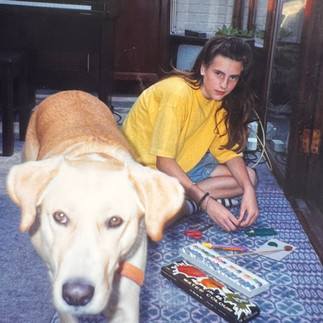Being an Artist: How did that happen?
- Louise Earnshaw

- Aug 21
- 4 min read
"How did you become an artist?" is a question I frequently receive.
As adults, we often can't recall specific aspects of our childhood, especially before the age of five. Many people mention they don't remember learning to read; as someone with dyslexia, I do remember—it was challenging. However, if you ask me about learning to draw, I have no recollection.
My favorite activities involved paper, pencils, felt tips (known as marker pens in my day), and paints. I had a strong desire to draw, although I'm not quite sure why. I created illustrations depicting stories about my teddy
bears, replicated drawings from picture books, and taught myself how to draw animals, which made me popular among my friends.
As an adult reflecting on my need to draw, I believe it stemmed from several factors. It definitely served as an escape from reading, provided a means of communication when words failed me, and earned me praise, which helped counterbalance the negative feedback I received in school regarding my difficulties with reading and writing.
Aside from the rare moments when I fancied becoming a pirate, I always knew I wanted to be an artist. However, as I entered my teenage years, I observed that people often had a negative view of artists. They would say things like, "That's not a career!" or "Artists are poor!" or "What a waste of time drawing pictures!" These sentiments grew stronger as I began thinking about going to university.
Initially, I never thought about going to university because I doubted my intelligence and believed it wasn't something our family typically pursued, as my parents hadn't attended either. Additionally, I questioned whether studying art was a worthwhile investment of time and money. Fortunately, I had the strongest support possible from my parents. They encouraged me to pursue what would bring me happiness and motivation. Unlike others, they never made any discouraging remarks. So, I found myself preparing to leave home to study art for three years.
Initially, I planned to remain at home and study illustration locally. However, I discovered a course in South Wales called 'Wildlife Illustration.' Since much of my previous studies involved drawing and painting animals and landscapes, I felt this could be perfect for me, especially if it were closer to my family and my mum's cooking. But my very wise dad posed a straightforward question: 'Do you want to study Wildlife Illustration?' My answer was yes, and so I ventured miles away from home to reside in tranquil Carmarthenshire.
It was the best thing I could have done, it taught me independence, problem solving and how to cook not to mention days spent outside drawing, sketching and learning about nature. We had days in the studio, tutorials in the Mac suite and my favourite sketching day trips. One morning I arrived to be told we were jumping in the mini bus for a day trip on Skomer Island drawing Puffins. It was heaven!
After I completed university, feeling very proud of my qualifications, the doubts from my teenage years resurfaced. What will you do with an art degree? What a waste of time! Honestly, this was the first time reality struck me—what was I going to do?
Initially, I applied for illustrator positions at several greeting card companies, but my inexperience consistently proved to be an obstacle. Meanwhile, a friend of mine was already employed as an art teacher, and since I had enjoyed volunteering with young people, I decided to return to university to pursue a postgraduate certificate in education. However, did this mean I wasn't truly an artist?
Now, 23 years have passed, and I have a 20-year career as an art teacher. During this time, I never labeled myself as an artist, but I was and still am one. Every day, I demonstrated a wide range of skills, practiced how to teach specific techniques or use certain media, learned new methods to enhance my curriculum delivery, and drew inspiration from other artists.

I transitioned from classroom teaching a little over two years ago and now identify as an artist. I have a studio in my garden where I create and sell art, but these factors alone do not define me as an artist.
My ongoing urge to use materials to visually capture the world around me is what defines me as an artist. The results I produce aren't crucial to my identity as an artist; selling my work is just one aspect. It's the sensation I experience, reminiscent of being 5 years old, when I escape from the world to concentrate on the marks I create—that's what being an artist truly means to me.
I hope this has given you a little insight into why art is so much a part of me and why I still teach workshops in the hope that everyone can find calm, joy and focus away from a busy world through making marks on a surface.








Comments